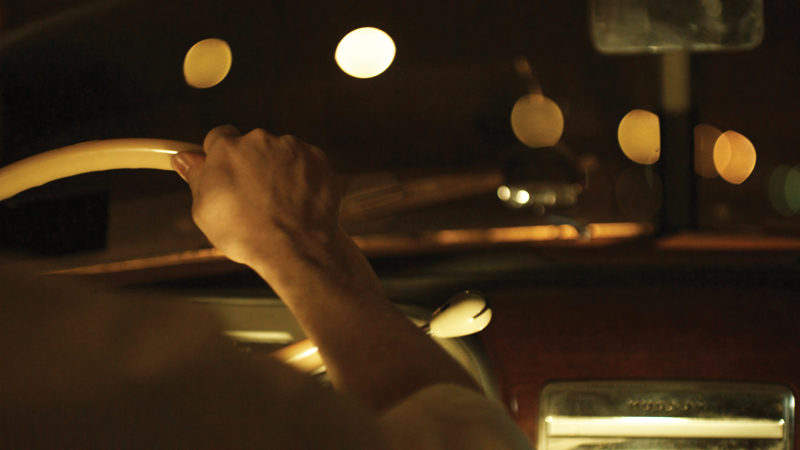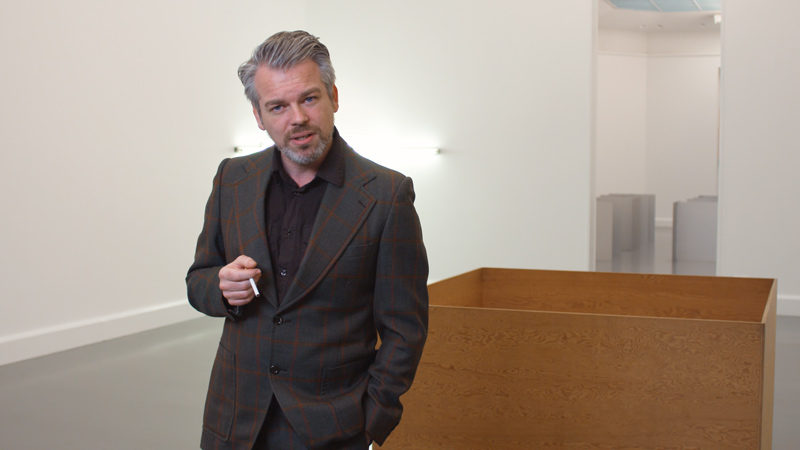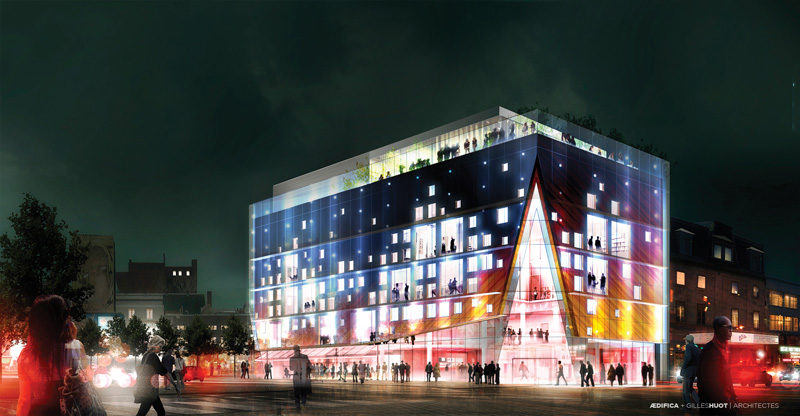[Fall 2011]
by Jacques Doyon
Jacques Doyon : For more than ten years, VOX has had an ambitious program, emphasizing “conceptual paradigms” and casting an analytic gaze at recent history and artworks that are precursors of current practices. You have created tools and resources to extend the impact of your research (publications, documentation Web site, educational activities) and established numerous partnerships (guest curators, co-production, touring exhibitions). The new location and resources thus both bring recognition to your work and give you the means to deploy it fully and continually. In its new space, VOX will more than double the size of its exhibition space and possess the latest equipment. In itself, that is a remarkable accomplishment. At the same time, this is a major challenge for a small organization such as yours. My first question is about the new status of the centre, which is now looking more like an exhibition centre. How would you define VOX in a context such as Montreal’s, divided among artist-run centres, museums, university galleries, private galleries, and, more recently, private foundations?
Marie-Josée Jean: This is a question that concerns me and my board of directors, and we have been reflecting on it for quite some time. Our new facilities will in fact be comparable to those of an exhibition centre, but our way of operating (and being), which has always been based on self-management, resembles that of an artist-run centre. What we are actually wondering is, “What do we want to do in this new context?” The answer, we believe, will determine what we will be. The question “What is an artist-run centre?” – its functions as a political and philosophical undertaking but also from the point of view of practice – has for some time been the subject of a very interesting debate among actors in the Vancouver art scene.1 What seems fundamental in this debate, aside from the different positions, is the fact that the artist-run centre is seen not just as a legitimate circulation or production structure – with its vices and virtues – but as a topic of discussion, and it is starting to be the subject of studies and reflection, which I find fascinating. That research is being done on artist-run centres is exciting in large part because they have acted as laboratories for artists (and some exhibition curators) for forty years now.2 Projects that have been produced and circulated through artist-run centres are now providing material for both thought and appropriation to a new generation of artists and researchers. The artist-run centre has been and remains a site for experimentation, production, and dissemination, and it must be said that it has become a form of institution for artists. It is fundamentally an open place that is capable (in a stunningly short space and time) of being transformed, of adapting, of (inter)acting, and, perhaps something new, of reflecting on itself. Will it be possible to broaden this definition to the point of considering the artist-run centre a site of research? I don’t know yet if this vocation will be accepted by peers. This question concerns me particularly because research determines our future programming. I am referring here to a form of applied research, performed as much by artists and exhibition curators as by art theorists who want to delve into issues of a visual, aesthetic, museological, institutional, social, or theoretical nature. This research will also be inward-looking, since I plan to include in our program conferences, exhibitions, and projects that will reflect research as an artistic methodology, as well as the history of exhibitions and ephemeral practices including, obviously, those performed in situations self-managed by artists. The status of vox will depend in large part on the means that we will have at our disposal to attain our development objectives. I consider vox a hybrid organization somewhere between an artist-run centre, an exhibition centre, and a university gallery – an institution that wishes to remain close to artists.
JD: VOX has produced a number of touring exhibitions with European partners, and you take frequent trips abroad. How do you envisage the interaction between local and international? Is it based on special partnerships? Do you plan to host exhibitions produced elsewhere in Canada or abroad, or will you maintain the model of circulating Quebec art to other countries?
M-J J: I was recently rereading Paul-Émile Borduas’s account of some of his experiences on the international scene, mainly in New York and Paris. I was surprised to realize that the difficulties he had during these years were about the same as those we have today: Quebec has a hard time getting its visual art production out into the international circulation networks. Back in 1956, Borduas was asking why this was so, when “the problems that we are trying to solve are just about the same. Research here is sufficiently consolidated to face comparison with the world. Why is it that our proud and ardent Canadian [that is, French Canadian] responses, once they leave the country, trigger no discussion?”3 The situation hasn’t changed much, considering that in the spring of 2010 there was a major exhibition at the Museum Kunstpalast in Düsseldorf, which, in a revisionist current, offered a new history of action painting by reintegrating practices that had developed on the edges of the cultural centres in New York and Paris.4 However, Quebec automatists were not represented, despite the fact that their formal research, bold and original at the time, preceded that of many action painters. A second event, this one at the Tate Modern in London, also in 2010, offered a forum for more than seventy artist-run centres on the international scene with the intention of bringing to light the role that this network plays in global research and in circulation of artworks.5 Once again, Quebec was not represented, despite the importance of its network of artist-run centres. This does not mean that Quebec artists and exhibition centres have no presence abroad; on the contrary, many of us design and produce projects, but these initiatives, generally created on an ad hoc basis, are clearly no longer enough.
The situation is of concern to VOX, and we decided to conduct a study to gain a better understanding of this state of affairs so that we can formulate a plan for international circulation of Quebec art. Right now, of course, I don’t have concrete solutions to this problem, but I am analyzing a number of models, and this is one of the reasons I’m travelling abroad. In the context of globalization, it is obvious that the ways artworks are circulated are being transformed; today, there is much more emphasis on co-production and insertion into networks than on a vision of national art exports. In my opinion, it is therefore essential and urgent for organizations, researchers, and artists to become involved in what I call international networks with aesthetic affinities. If we look at the situation in Quebec, most institutions – including artist-run centres, exhibition centres, and museums – have become very professionalized and mature. Yet, few of them have adopted a clear artistic profile or firm aesthetic identity. In my view, it is not enough to promote contemporary art without a defined artistic orientation if one hopes to position oneself outside of Quebec. It is also necessary to envisage initiatives designed to bring art distributors and collaborators from other countries to Quebec. A number of Quebec institutions suffer from a lack of perspective, and they only rarely hire researchers or curators from abroad, young or established, who would certainly contribute to enriching our reflections. Obviously, we plan to work with various organizations and contributors in Canada and abroad and to host or co-produce exhibitions. We have a number of projects under discussion. We will also try to provide better guidance to artists with a view to longer-term circulation of their work. We must recognize, in fact, that few Quebec artists have an international career, even though many of them are involved in exhibitions and residencies in Canada and abroad. This is explained in part by the fact that few dissemination structures in Quebec guide artists in this difficult long-term project. Yet, to achieve this, we have to devote more effort to ensuring their presence beyond Quebec’s borders, which have become too restrictive.
JD: Are there any institutions, in Quebec or elsewhere, that have had a particular influence on your ideas about developing VOX?
M-J J: Yes, of course. I am observing with great attention and curiosity the institutions that share our aesthetic choices – those that present conceptual practices and wish to establish a trans-historical dialogue and also those that are inventing new means of circulating and exhibiting works. For instance, I am fascinated by the programming of the Generali Foundation in Vienna and the Musée d’art contemporain in Barcelona, both of which have delved deeply into the exhibition of works many of which had not been seen since the 1960s and 1970s, including, for example, the reactivation of archives and historical exhibitions. Presentation House in Vancouver and the Ryerson Gallery in Toronto are image-based centres that, like vox, are engaged in new construction projects, and I stay in touch with them. I am keeping an eye on the initiative by Or Gallery, an artist-run centre in Vancouver that has just opened a satellite gallery in Berlin. The exhibitions organized by Carriage Trade, a new artist-run centre in New York that creates exhibitions using a post-media strategy, are of great interest. I am also following the projects of La Secession in Vienna, the oldest artist-run centre, which is systematically engaged in new production by artists, and the Musée d’art moderne et contemporain in Geneva, which has implemented a progressive approach to exhibitions by conserving the trace of past exhibitions in the new hangings. The history of artist-run centres, including some that have disappeared, is a definite influence on me. I am thinking of Véhicule Art in Montreal, Intermedia Society in Vancouver, and Foksal Gallery in Warsaw.6 Yes, the research undertaken by these different organizations is very important to us, and we hope to be able to engage in joint projects with some of them, and even to reconstruct significant actions or exhibitions that they have produced; in fact, this is something that we are currently attempting to do.
JD: Your mandate is focused on the artistic issues in contemporary images, both fixed and moving. Aside from the visual, aesthetic, and theoretical dimensions, you seem to want to place renewed emphasis on the museological, institutional, and social issues of the image in contemporary art. Could you describe a bit more concretely what the axes of such an investigation would be? Might it go so far as an examination of the omnipresence of the image in society that draws on the vision and knowledge from other areas of image-based expertise?
M-J J: VOX’s position is that we must go beyond the disciplinary limitations of art and – in a more assertive way in the future, I hope – its historical categorizations. We consider the image from a post-media point of view in that it is above all a phenomenon – aesthetic, technological, social, historical, and so on – at the intersection of several media, and one that can be grasped only in the light of a number of disciplines. This gives rise to the need for us to place fixed or moving images in dialogue with texts (advertising, theoretical, or literary), with other media, or with discursive practices in various areas. In our new context, we will have museum conditions – that is, a controlled-atmosphere system so that we can present historical works in a proper environment – so that we will be able to encourage dialogue among different his-torical periods. We will also have facilities for holding public discussions and presenting a continuous program of films. Our intention is to encourage research and experimentation, as well as to stimulate production of knowledge concerning image-based practices. For us, the image presents a field of investigation that is still stimulating – even after twenty-five years – and it will be up to our future partners (artists, researchers, curators, and so on) to invent new theories through which new works and new knowledge will be generated.
JD: Another important issue, for the centre but also for the arts and culture sector in Montreal, is the impact of your activities on a public interested in contemporary culture. Your plan to relocate, along with several close partners, to 2-22, in the heart of the cultural district, will offer you increased visibility and visitors. Up to now, artist-run centres, despite their best efforts, have not completely succeeded in positioning their public programs into the city’s cultural reality, due to very limited means. How will you familiarize the public with contemporary art production and with the results of the work and research that you will present?
M-J J: It will be a challenge, I agree, for our small team. But starting with the idea that artworks are sensory presences as well as discursive practices, our intention is to create a program of exhibitions and mediation activities that may interest a variety of audiences – those looking for a stimulating aesthetic experience as well as those who are interested in theoretical contributions. We will do our best to meet the expectations of different audiences, although we are aware that our programming will not interest everyone. We intend to experiment with new avenues, including activities organized for specific audiences. This is obvious for the lecture series that we hope to organize for specialized audiences, but it could also take the form, for instance, of an exhibition curated by an artist especially for children, similar to children’s literature or theatre for young audiences, but with content that is not infantilizing. There will also be the possibility of guided tours for people who want to learn more.
That said, we are not alone in the new venture at 2-22, fortunately. VOX will occupy the entire fourth floor. Artexte and the Regroupement des centres d’artistes autogérés du Québec will share the third floor, and the community radio station cibl and the Vitrine culturelle will occupy the first two floors. There will be a café and patio on the roof and a restaurant on the ground floor. The last two floors, devoted to contemporary art, will house VOX’s exhibition spaces, a contemporary-art bookstore managed by RCAAQ, and the Artexte documentation and research centre, which will inaugurate a brand-new exhibition space. There will be much traffic through the building, and much contemporary art will be on display. It means a new context and new audiences for each of us. The idea is to move there, develop a program of activities, experiment with new mediation approaches, and, ultimately, adapt to our new reality.
Translated by Käthe Roth
1 On this subject, see Keith Wallace, “Artist-Run Centres in Vancouver: A Reflection on Three Texts,” Fillip, no. 12 (autumn 2010); Reid Shier, “Do Artists Need Artist Run Centres?,” in Melanie O’Brian (ed.), Vancouver Art and Economies (Vancouver: Arsenal Pulp/Artspeak, 2007).
2 The Pacific Association of Artist Run Centres (ArcPost), in collaboration with the contemporary art magazine Fillip, is currently compiling data concerning the culture and history of artist-run centres. See arcpost.org. ArcPost and Fillip are also planning a congress in 2012 to discuss the distance between the initial intention and the reality of artist-run centres and all self-managed art activities.
3 Paul-Émile Borduas, Refus global et autres écrits, edited and introduction by André-G. Bourassa and Gilles Lapointe (Montreal: Éditions Typo, 1997), p. 221 (our translation).
4 The only artist in the exhibition considered a member of the Paris School was Jean-Paul Riopelle. That said, this exhibition was organized with the admitted intention by the curators to reinsert German Art Informel into this international historical account. See, on this subject, “Le Grand Geste! Informel and Abstract Expressionism, 1946 –1964,” Museum Kunstpalast, Düsseldorf: www.eflux.com/shows/view/7972; Roald Nasgaard, “Le Grand Geste!: Automatiste for the People,” Canadian Art (spring 2011). Available at www.canadianart.ca/art/features/2011/04/14/roald_nasgaard_les_automatistes/. Consulted 20 June 2011.
5 The event, No Soul For Sale – A Festival of Independents, was held in May 2010. See www.nosoulforsale.com/2010. Consulted 20 June 2011.
6 It is interesting to note that this parallel gallery, founded in 1966, was inaugurated with the publication of a “general theory of the site,” thus making the exhibition an axiomatic component in the creation of the works presented.
Jacques Doyon has been the editor-in-chief and director of Ciel variable since January 2000.



